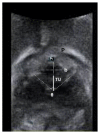Ultrasonographic Assessment with Three-Dimensional Mode of the Urethral Compression Effect following Sling Surgery with and without Mesh Surgery
- PMID: 30723744
- PMCID: PMC6339735
- DOI: 10.1155/2019/8285351
Ultrasonographic Assessment with Three-Dimensional Mode of the Urethral Compression Effect following Sling Surgery with and without Mesh Surgery
Abstract
Background: The aim of this study was to assess anatomical changes in the urethra at rest and during straining following sling surgery with and without transvaginal mesh surgery (TVM) in women with stress urinary incontinence (SUI) with or without pelvic organ prolapse (POP) using three-dimensional ultrasonography.
Methods: 76 women with SUI with or without pelvic organ prolapse after sling surgery. They underwent sling surgery alone (S group, n=36) or concomitant TVM (M group, n=40). All patients underwent urinalysis, pelvic examinations, urodynamic study, 3D perineal ultrasonography, and personal interviews before and 1 year after surgery. The urethral area was calculated from the axial plane of perineal ultrasonography by multiplying π by the long and short axes of the urethral lumen.
Results: The axial area of the middle and distal urethra during straining was significantly smaller than at rest in both groups (P<0.001). In addition, the length of the short axis of the proximal urethra was significantly shorter in those undergoing sling surgery alone during straining compared with those undergoing concomitant sling and mesh surgery (P<0.001).
Conclusions: There was a greater impact on the proximal urethra in women who underwent sling surgery alone than those who underwent sling and TVM surgery together.
Figures


References
-
- Ogah J., Cody J. D., Rogerson L. Minimally invasive synthetic suburethral sling operations for stress urinary incontinence in women. Cochrane Database of Systematic Reviews. 2009;7(4)CD006375 - PubMed
MeSH terms
LinkOut - more resources
Full Text Sources
Medical
Research Materials
Miscellaneous

